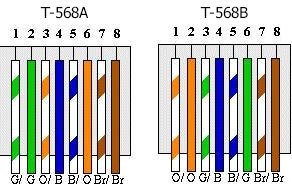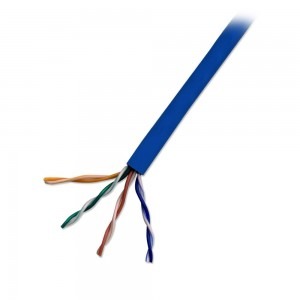
Confused by T568A and T568B? This guide decodes the two most common wiring standards for twisted-pair network cables, ensuring you connect everything right the first time.
Key Takeaways:
- T568A and T568B are both valid wiring schemes for eight-position modular connectors.
- They differ in how they assign colors to pin locations.
- T568A is based on an older phone standard, while T568B follows a commercial standard.
- Neither scheme is inherently better, as long as both ends of the cable are wired the same.
Q: What are the differences between T568A and T568B wiring standards?
A: T568A and T568B use different color assignments for pin locations on eight-position modular connectors. T568A follows an older phone standard, while T568B is based on a commercial standard. Neither scheme is technically superior, as long as both ends of the cable are wired consistently.
T568A and T568B are the wiring standards that define the pinout (connection order) for terminating twisted-pair network cable in eight-pin modular connector plugs and jacks. These wiring standards are one part of the TIA/EIA-568 telecommunications cabling standards. The American National Standards Institute (ANSI), Telecommunications Industry Association (TIA), and Electronics Industries Alliance (EIA) are in agreement on the use of T568A and B.

Both standards specify the wiring schemes for the connection of twisted-pair copper cable into eight-position RJ45 connectors and jacks for data transmission. The twisted-pair cable is comprised of four wire pairs that provide eight conductors. The pairs feature blue, orange, green and brown colours. Each pair has a solid colour wire and another wire that is the same colour, with white stripes. Once the pairs are untwisted, eight separate wires are available to match the eight pins on a jack or plug.
The T568B Wiring Standard
In commercial environments, the T568B wiring standard is more commonly used for telecommunication installations. However, the 568A assignments are frequently seen in residential applications. Cabling expansions are made according to a network’s current wiring scheme in order for wires to match up and data signals to transmit. Both T568A and T568B wiring standards are straight-through schemes.
The Difference in T568B and T568A Wiring Schemes
The pair-to-pin assignments are different in the T568B and T568A wiring schemes. This difference is easily seen with pin positioning. The green and orange pairs (2 and 3) are switched. Patch cords can be purchased that are pre-wired for T568B or 568A connectivity.
TIA/EIA-568-B defines cable and connectors to be used in networks. The TIA and EIA standards for Category 6a cables support 10GBase-T networks. Like Cat5e, the Cat6 cables are usually terminated in 8P8C connectors. However, the wiring must be supported by patch cables, jacks and connectors that are also rated for the Category 6 TIA/EIA performance. At Comms Express, components are available which are compatible with the larger 6a cables.
The difference in T568B and T568A wiring schemes is important to understand when terminating RJ45 connectors for Ethernet cables. These two schemes are the most common standards for wiring eight-position modular plugs and jacks. They use the same type of plug, but the order of the colour-coded wire pairs is different. The green and orange pairs (2 and 3) are swapped in the T568B scheme compared to the T568A scheme.
The reason for this difference is historical and has to do with the evolution of telecommunication standards and technologies. The T568A scheme is based on the older USOC (Universal Service Order Code) standard, which was used for telephone wiring before the advent of high-speed data networks. The USOC standard assigned the green pair to the first line and the orange pair to the second line of a two-line phone system3. The T568B scheme is based on the AT&T 258A standard, which was widely used in commercial and residential installations in the past. The AT&T 258A standard assigned the orange pair to the first line and the green pair to the second line of a two-line phone system.
The difference in wiring schemes does not affect the performance or functionality of Ethernet cables, as long as both ends of the cable use the same scheme. However, if one end of the cable uses T568A and the other end uses T568B, then the cable becomes a crossover cable, which reverses the transmit and receive pairs. This can cause communication problems between devices that expect a straight-through connection. Therefore, it is important to be consistent and use the same wiring scheme for all Ethernet cables in a network.
The choice of which wiring scheme to use depends on several factors, such as customer preference, contractual requirements, or compatibility with existing equipment. Some devices, such as routers, switches, or hubs, may have both T568A and T568B labels on their ports to indicate which scheme they support. Some wall sockets or patch panels may also indicate both schemes internally to help with termination5. In general, there is no technical advantage or disadvantage to using either scheme, as long as it is done correctly and consistently.
Some key terms that are related to this topic are:
RJ45: A common name for an eight-position modular connector that is used for Ethernet cables. RJ stands for registered jack, which is a standardized interface for telecommunication devices.
Pin: A metal contact in a modular connector that connects to a wire in a cable. Pins are numbered from 1 to 8 from left to right when looking at the front of a plug or socket.
Pair: A set of two wires that are twisted together in a cable to reduce interference and crosstalk. Pairs are color-coded according to a standard scheme, such as white/blue and blue for pair 1, white/orange and orange for pair 2, etc.
Termination: The process of attaching a modular plug or jack to a cable by inserting the wires into the appropriate pins according to a wiring scheme.
Crossover cable: A type of Ethernet cable that has one end wired with T568A and the other end wired with T568B. This reverses the transmit and receive pairs and allows direct connection between two devices without a switch or hub.
Straight-through cable: A type of Ethernet cable that has both ends wired with the same scheme, either T568A or T568B. This maintains the transmit and receive pairs and requires a switch or hub to connect two devices.
Contact Comms Express for more inquiries regarding patch lead standards, or to find a patch lead that meets your requirements.
Related Links
RJ45 Connectors & Adapters
Network Installation & Essentials
